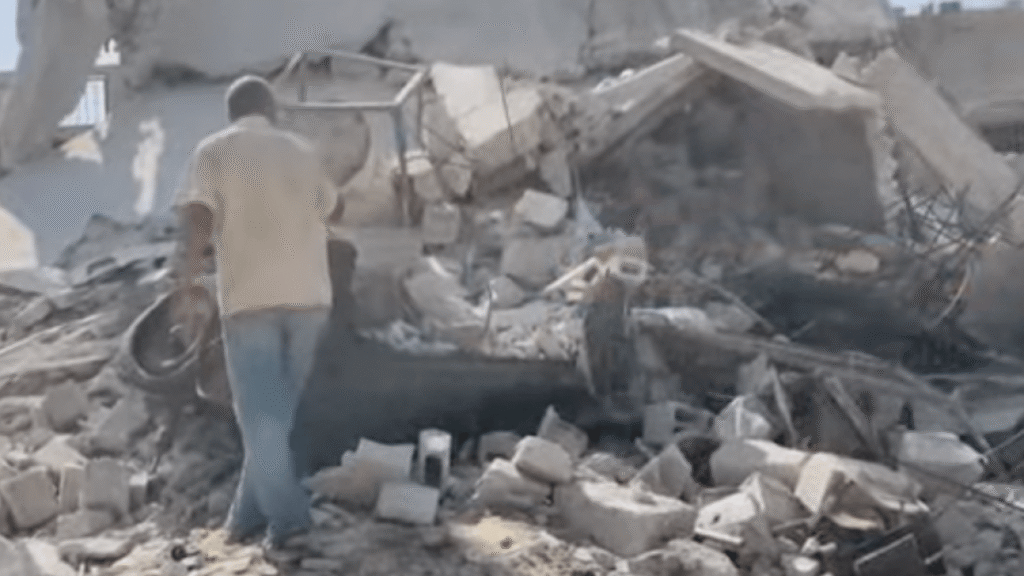Remotely operated explosive robots were deployed by Israel across Gaza, causing many Palestinian civilian deaths, widespread destruction.
A Palestinian man returning to his Gaza neighbourhood destroyed by Israeli bombardment has found an unexploded Israeli armoured vehicle amid the rubble where he has had to set up temporary shelter.
Families began returning to the southern city of Khan Younis following the ceasefire that took effect on October 10, joining more than 435,000 people who have made their way back in the other direction to northern areas from displacement camps further south.
Many have found neighbourhoods razed to the ground, tangled metal and even dangerous weapons where there used to be residential buildings and homes.
With nowhere to settle and large parts of Gaza still occupied by Israel’s army, Ayman Qadourah has resorted to pitching his family tent over a hulking military machine, known locally as an “explosive robot“, which carried powerful bombs used to flatten entire blocks.
The remotely operated explosive robots were deployed by Israel across urban areas in Gaza, causing widespread damage to infrastructure.
Qadourah came back to his home in Khan Younis a month ago. His neighbour’s house contained another explosive-laden device, he said. An F-16 missile had carved a crater three metres deep between the two properties, while two more struck the rear of his home.
“Unexploded devices like that are a serious hazard,” he told Al Jazeera. “For example, if any flammable liquid comes close to it the flames will be massive, sky high.”
Qadourah worries that if one of the explosives detonates, it could obliterate an entire neighbourhood. To reduce the risk, he regularly covers the machines with sand.
In early September, Gaza’s Government Media Office reported that Israel had detonated more than 100 explosive-laden robots over the final three weeks of August.
Satellite analysis by the United Nations Satellite Centre (UNOSAT) found that across the Khan Younis governorate, more than 42,000 buildings were affected, with the city itself, the Gaza Strip’s second most populous, accounting for at least 19,000 damaged structures.
Across the entire Gaza Strip, more than 227,000 housing units have been damaged, according to UN assessments, leaving hundreds of thousands of people with nowhere to return to or live.
Luke David Irving, who heads the UN’s Mine Action Service in the occupied Palestinian territory, describes the threat from explosive ordnance across Gaza as “incredibly high”. His agency has identified at least 560 such devices in areas it has been able to reach, though the true scale remains unknown.
Since October 2023, 328 people have been killed or injured by unexploded ordnance, according to reports received by the UN, though the toll is believed to be higher.
Qadourah’s children now wear clothes he pulled from beneath the rubble. The garments have caused severe skin infections, including rashes and abscesses.
“Despite all that, we are forced to live here, because there are simply no alternatives. Currently, there is nowhere to go,” he said. “There isn’t an inch of space left”, he added, referring to the crowded conditions at the al-Mawasi camp in the south.
Palestinians who have remained in the south “will not budge until a permanent solution is reached” to the housing issues, Qadourah added.
Humanitarian agencies have ramped up aid deliveries since the ceasefire, distributing food, tents, hygiene supplies and fuel, but Israel continues to heavily restrict the flow of aid, and the target of getting 600 trucks into the devastated and desperate enclave a day is currently far from being a reality.
https://www.aljazeera.com/news/2025/10/25/gaza-returnee-places-family-tent-over-unexploded-israeli-bomb?traffic_source=rss


